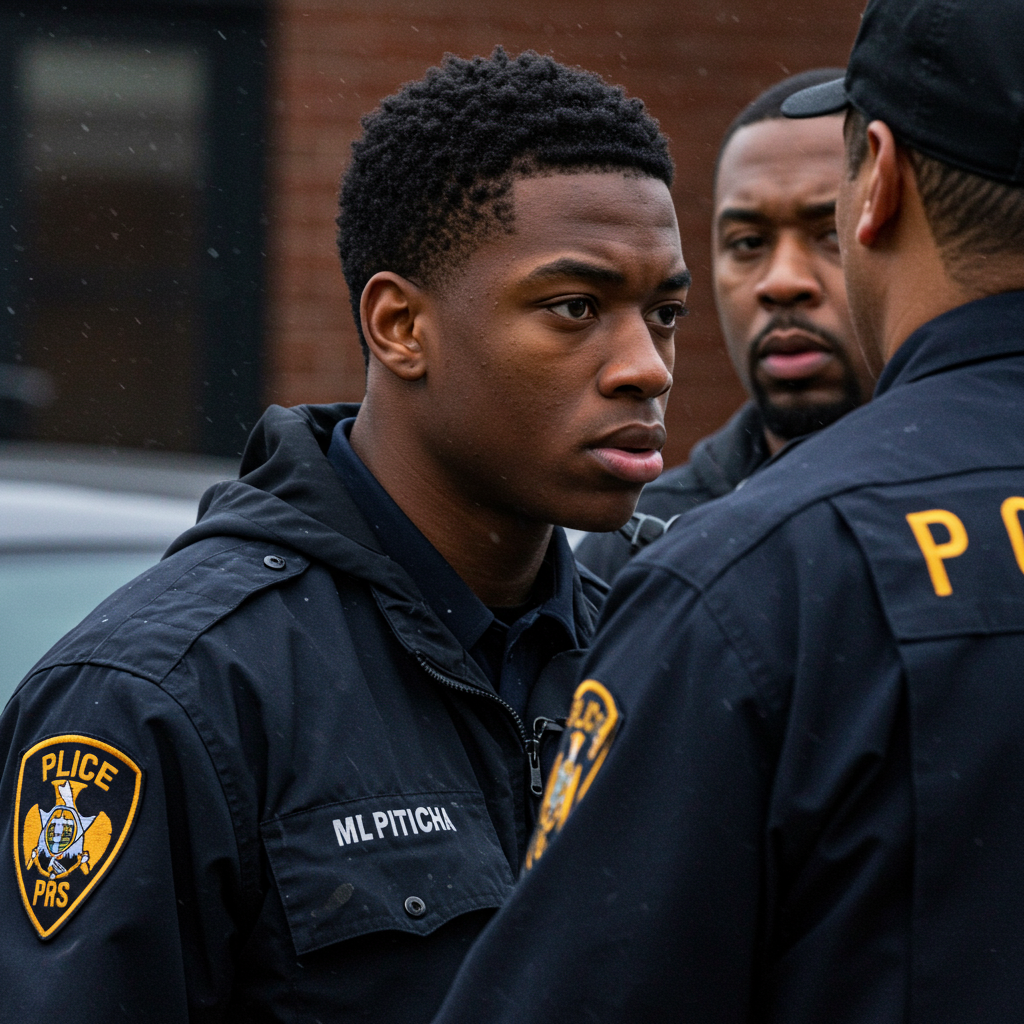The nation watched as authorities swiftly apprehended Tyler Robinson, 22, in connection with the fatal shooting of conservative activist Charlie Kirk. Kirk, a prominent voice and co-founder of Turning Point USA, was tragically killed during a campus event at Utah Valley University (UVU) on Wednesday, September 10. Robinson’s arrest on Friday, September 12, marked the culmination of an intensive multi-day manhunt, drawing national attention and igniting conversations about political violence. Initial charges against Robinson include aggravated murder, felony discharge of a firearm causing serious bodily injury, and obstruction of justice.
The Tragic Event at Utah Valley University
On September 10, the Utah Valley University campus in Orem became the scene of a shocking attack. Charlie Kirk was addressing an estimated crowd of 3,000 people when he was fatally shot in the neck. Governor Spencer Cox swiftly condemned the act, characterizing it as a “political assassination” and a direct “attack on all of us.” Law enforcement, including FBI Director Kash Patel, noted their rapid response, with officers on the scene within 16 minutes of the incident.
Surveillance footage reviewed by investigators provided crucial early insights. It showed the alleged gunman arriving on the UVU campus at 8:29 a.m. in a gray Dodge Challenger. The suspect, later identified as Robinson, was initially seen in a maroon T-shirt, light shorts, light shoes, and a black hat. Investigators determined he changed into dark clothing on campus before the shooting, then reverted to his original attire afterward. This meticulous planning hinted at a premeditated act, as observed by retired FBI agent Brad Garrett.
The Manhunt and Swift Apprehension of Tyler Robinson
The pursuit of Charlie Kirk’s suspected killer involved local, state, and federal agencies, processing over 7,000 tips and conducting some 200 interviews. Key surveillance images of a person of interest, including distinctive Converse sneakers and a video of the individual jumping from a campus rooftop, were widely distributed. This crucial public appeal ultimately led to a breakthrough: Tyler Robinson’s own father recognized his son in the released photographs.
Robinson’s father contacted authorities through a family friend, who also happened to be a U.S. Marshals task force officer. He urged his son to surrender. Although initially hesitant, Robinson reportedly agreed to turn himself in. This information was then relayed to the FBI, leading to his apprehension in St. George, Utah, within 33 hours of the shooting. Utah Governor Spencer Cox publicly expressed gratitude to Robinson’s family for “doing the right thing” during a press conference confirming the arrest. Former President Donald Trump was notably the first to announce the arrest on Fox News, even before official confirmation.
Unraveling the Evidence: Digital Clues and Forensic Findings
The investigation quickly amassed a significant body of evidence connecting Robinson to the crime. Surveillance footage meticulously tracked his movements across the UVU campus. This included navigating stairwells, traversing a rooftop to the shooting location, and his subsequent escape by jumping from the building into a nearby neighborhood. This detailed video timeline was instrumental in understanding the sequence of events.
The suspected murder weapon was identified as an older model imported Mauser .30-06 caliber bolt-action rifle, found wrapped in a towel in a wooded area near UVU. Its location appeared to match Robinson’s escape route, suggesting a deliberate attempt to discard the firearm. The recovered rifle, along with cartridges, was flown to the FBI’s main laboratory in Quantico, Virginia, for advanced forensic analysis, focusing on latent fingerprints and DNA. Investigators also collected a footwear impression, a palm print, and forearm prints from the scene.
Disturbing Inscriptions: Messages on Bullet Casings
A particularly chilling aspect of the evidence emerged from the bullet casings recovered at the scene. Investigators found unique and provocative inscriptions etched onto the fired casing and three unfired bullets. These messages offered a disturbing glimpse into the suspect’s potential mindset and online cultural influences.
The fired casing reportedly bore the phrase: “Notices bulges OwO What’s This?”, a reference to an internet meme associated with “furry culture” and video gaming. Among the unfired casings, one read: “Hey fascist! CATCH!” accompanied by an arrow symbol and a sequence of three down arrows, which is a known anti-fascist symbol or could allude to a video game “airstrike” meme. Another casing was inscribed with lyrics from “O Bella ciao,” the well-known Italian anti-fascist resistance song. A third unfired casing carried a crude, trolling-related message: “If you read this, you are GAY Lmao.”
Further digital evidence came from Robinson’s roommate, who provided authorities with messages between Robinson and the roommate. While initial reports suggested Discord messages, Discord later clarified that the messages were between the roommate and a friend, recounting content from a note Robinson had left. These communications detailed Robinson’s plans to retrieve a rifle from a “drop point” in a bush, engrave bullets, and mentioned a scope and the unique nature of the rifle.
A Glimpse into Tyler Robinson’s Life and Potential Motives
Tyler Robinson, a 22-year-old Utah resident, presented a complex profile to investigators. He lived with his family in Washington County, Utah, and public records indicate no prior criminal history. Robinson was not enrolled at UVU at the time of the shooting but was pursuing an electrical apprenticeship at Dixie Technical College. He had graduated from Pine View High School in St. George in 2021 and briefly attended Utah State University for one semester in the same year, reportedly on an academic scholarship for an ACT score of 34. His voter registration was unaffiliated, though his parents are registered Republicans. His mother’s social media also showed him in a Trump-related Halloween costume in 2017, adding another layer to the puzzle of his evolving political views.
Conflicting accounts of Robinson’s personality emerged from those who knew him. A former classmate described him as “friendly” but “a little more reserved,” stating they “never really heard him talk political” or express “hate or malice towards other people” or discuss guns. In contrast, a family member interviewed by investigators revealed that Robinson had become “more political in recent years.” This relative recounted a dinner conversation where Robinson mentioned Kirk’s upcoming UVU event and expressed strong dislike for Kirk’s viewpoints, stating Kirk was “full of hate and spreading hate.” Neighbors described Robinson as quiet, intelligent, and musically inclined, though with few close friends. Kristin Schwiermann, a long-time neighbor, expressed heartbreak for the family and speculated on the influence of social media on Robinson’s views.
Broader Implications and National Reactions
The Charlie Kirk shooting has resonated deeply across the United States, prompting a wide range of reactions from political figures and experts. Governor Spencer Cox described Kirk’s murder as a “watershed moment in American history,” drawing parallels to the political assassinations of the 1960s. He emphasized the negative impact of violent imagery circulating on social media and stated that Utah officials intend to “pursue the death penalty” in this case, a sentiment echoed by former President Donald Trump.
Turning Point USA expressed profound loss and thanked law enforcement for their swift action. Congresswoman Nancy Mace announced plans to introduce a resolution for Charlie Kirk to “lie in honor in the Capitol Rotunda.” Political scientist Cas Mudde, an expert on populism, contextualized the event within the broader landscape of American violence, noting over 300 mass shootings in the current year and numerous cases of political violence documented since the January 6th Capitol insurrection. While acknowledging the tragedy, Mudde expressed skepticism that Kirk’s death would fundamentally alter U.S. policy or the political climate, contrasting it with events that had transformative impacts in other countries. He highlighted the U.S. as “an incredibly violent country,” suggesting such incidents, while tragic, may not be “so remarkable” as to force significant change, particularly in the current political environment.
Frequently Asked Questions
What specific evidence led to Tyler Robinson’s arrest in the Charlie Kirk shooting?
Tyler Robinson’s arrest was a result of several critical pieces of evidence. His own father identified him from surveillance photographs released by authorities, then urged him to turn himself in. This was coupled with surveillance footage tracking Robinson’s movements at Utah Valley University, showing his arrival in a gray Dodge Challenger, clothing changes, and his escape route. Crucially, investigators recovered a Mauser .30-06 bolt-action rifle wrapped in a towel near his escape path. Digital communications, including notes recounted by his roommate, also detailed Robinson’s plans to retrieve and conceal a rifle and engrave bullets, which aligned with the unique inscriptions found on bullet casings at the scene.
What insights do investigators have into Tyler Robinson’s potential motive?
Investigators are still building a full picture of Tyler Robinson’s motive. However, several clues have emerged. A family member reported that Robinson had become “more political in recent years” and expressed strong dislike for Charlie Kirk and his viewpoints, knowing Kirk would be at UVU. The engraved messages on the bullet casings, such as “Hey fascist! CATCH!” and lyrics from “O Bella ciao” (an anti-fascist song), suggest political or anti-fascist leanings. Other inscriptions, like “Notices bulges OwO What’s This?” and “If you are reading this, you are GAY Lmao,” point to an engagement with online trolling culture. These elements together suggest a complex mix of political animosity and online influence.
How has the Charlie Kirk shooting been described by officials, and what are the broader concerns?
Utah Governor Spencer Cox described Charlie Kirk’s murder as a “political assassination” and a “watershed moment in American history,” expressing concern that it represents a broader “attack on all of us” and the “American experiment.” Former President Donald Trump and Governor Cox have both advocated for the death penalty for the perpetrator. The incident has also sparked broader discussions about political polarization and violence in the U.S. Political experts like Cas Mudde have contextualized it within a trend of increasing political violence, while also expressing skepticism that this single event will significantly alter the deeply entrenched political climate or policy.
Conclusion
The swift arrest of Tyler Robinson in the Charlie Kirk shooting represents a significant development in a case that has sent shockwaves across the nation. While law enforcement continues to piece together the full narrative, the detailed evidence, from digital footprints to etched bullet casings, paints a picture of a meticulously planned act driven by a complex mix of motivations. The tragic event at Utah Valley University serves as a stark reminder of the escalating political tensions in the United States, prompting urgent reflection on the nature of discourse, the impact of online extremism, and the imperative for de-escalation in an increasingly polarized society.



